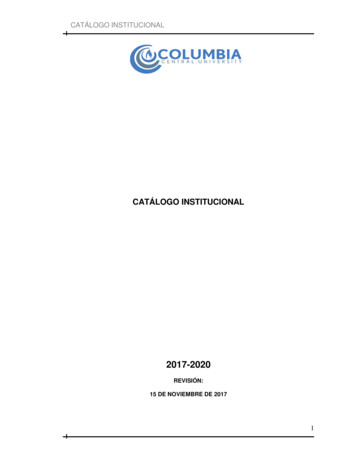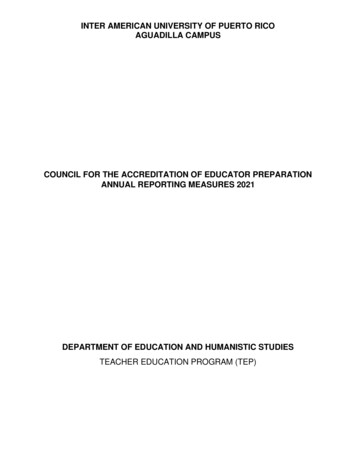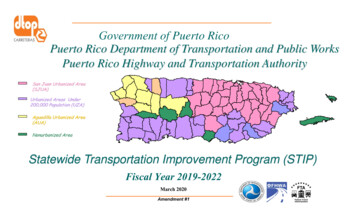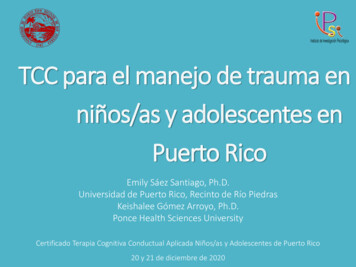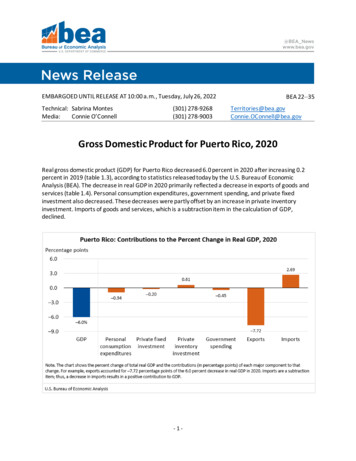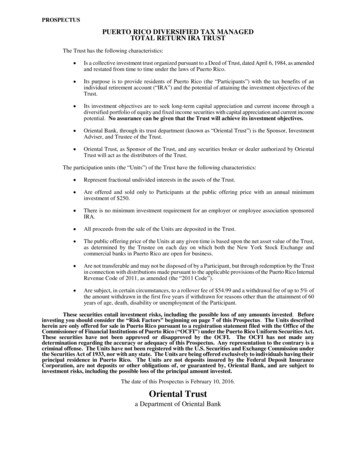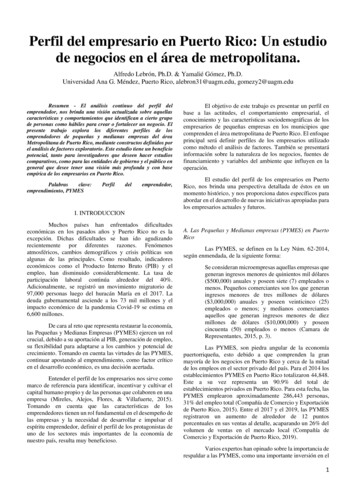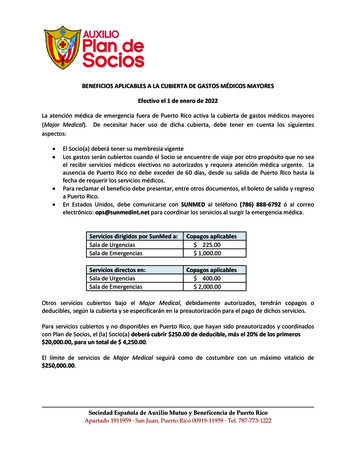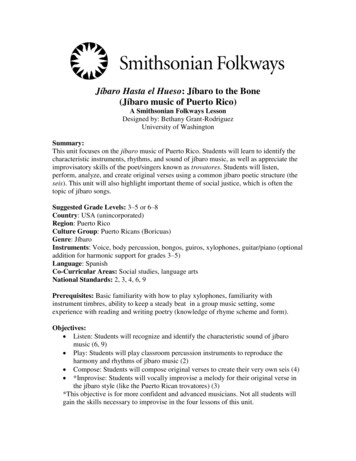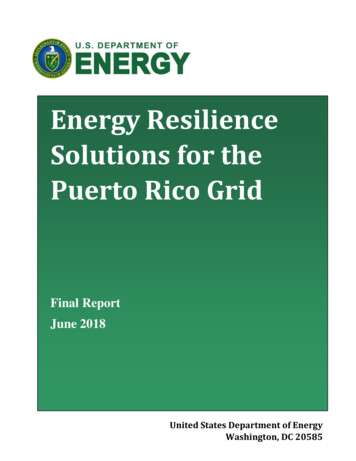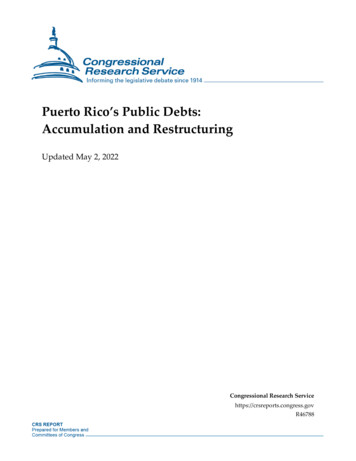
Transcription
Puerto Rico’s Public Debts:Accumulation and RestructuringUpdated May 2, 2022Congressional Research Servicehttps://crsreports.congress.govR46788
SUMMARYPuerto Rico’s Public Debts:Accumulation and RestructuringPuerto Rico’s public debts totaled just over 70 billion when the Puerto Rico Oversight,Management, and Economic Stability Act (P.L. 114-187; PROMESA) became law on June 30,2016. Most of those debts are now in the midst of perhaps the largest restructuring of public debtin U.S. history. By way of comparison, the City of Detroit owed about 18 billion when itentered bankruptcy in 2013. Puerto Rico’s debt restructuring has been one of the most expensiveever, with professional fees projected to exceed 1 billion.R46788May 2, 2022D. Andrew AustinAnalyst in Economic PolicyPROMESA created two paths for debt restructuring and established a Financial Oversight and Management Board (FOMB;Oversight Board). Title III established a debt restructuring process that draws on the Bankruptcy Code. Title VI set up a debtrestructuring process similar to some sovereign debt procedures. U.S. District Court Judge Laura Taylor Swain was chosen topreside over Title III cases. PROMESA conditioned the Oversight Board’s termination on Puerto Rico’s ability to access“short-term and long-term credit markets at reasonable interest rates.” The Oversight Board, after delays due to HurricanesIrma and María in September 2017, led efforts to restructure the island’s public debts through litigation and negotiations withthe Puerto Rican government, hedge funds, bond insurers, and others.Puerto Rico’s public debts fall into four categories: general obligation (GO) bonds and other debt payable through the mainTreasury accounts of the Commonwealth of Puerto Rico (CPR, the island’s central government); sales-tax-backed debtknown by its Spanish acronym COFINA and other revenue bonds; debt of public corporations such as the Puerto RicoElectric Power Authority (PREPA); and debt issued by local governments (municipios) and other smaller entities. InFebruary 2019, the Title III court confirmed the COFINA debt restructuring. Bonds with a par value of 17.6 billion werethen exchanged for 12 billion in new bonds.After several postponements in proceedings to restructure debts of the island’s central government, in early February 2021the Oversight Board announced an agreement with “certain bondholders” to restructure GO and related debts. The Boardfiled the corresponding amended plan with the Title III court on March 8, 2021. As 2021 progressed, several key creditorgroups agreed to support the plan. Compromises with the Commonwealth government and legislature led to enactment oflegislation to enable issuance of new debt securities and changes in how public pensions would be treated. On August 2,2021, the Title III court approved a disclosure statement and scheduled hearings on confirmation of the plan. On January 18,2022, the court confirmed a plan of adjustment to restructure debts of the Commonwealth of Puerto Rico and certain closelylinked public authorities, as well as pension plans for teachers, public employees, and judges. That confirmation resolvesvarious legal disputes. On March 15, 2022, the plan was consummated. Recovery ratios vary by debt class, although for olderGO bonds recovery rates were estimated to reach as high as 95%. Attention now shifts to addressing debts of PREPA, theisland’s troubled electric power utility.This report outlines the accumulation of the island’s public debts and how they are being restructured. Puerto Rico has faceda series of fiscal challenges since its postwar economic development strategy of industrialization faltered in the early 1970s,including acute budget crises in 2006-2007 and 2013-2016. The island’s lack of access to a means to restructure its debts ledto PROMESA’s enactment. This report focuses on the largest parts of the island’s public debt. For brevity’s sake, it discussesrestructuring of debts issued by PREPA, the Highways and Transportation Authority (HTA), and smaller public corporationsonly in passing. The Puerto Rico Aqueduct and Sewer Authority’s (PRASA’s) relatively stronger finances have kept it fromhaving to restructure its bonds. On May 11, 2021, the Oversight Board affirmed its support for a restructuring plan forPREPA, which had been delayed because of the COVID-19 pandemic, among other disruptions.Hedge funds, which generally tolerate more financial risk than many traditional investors, have played prominent roles inPuerto Rico’s debt restructuring. As default risks on Puerto Rican public debt became evident, many mutual funds reducedtheir holdings, allowing some hedge funds to increase theirs. In spring 2020, some accused hedge funds of trading on privateinformation obtained through confidential Title III negotiations. In June 2020, Judge Swain required parties to disclose moreabout their holdings. Some called for investigations of alleged trading on nonpublic information obtained in debtnegotiations. Legislation was introduced during the 116th Congress (e.g., H.R. 6975, H.R. 683, S. 1675) to amend PROMESAin ways that could affect debt restructuring processes. A measure (P.L. 117-82) mandating professionals working on theisland’s debt restructuring to make certain disclosures was signed into law in January 2022. Appendices to this report listCongressional Research Service
Puerto Rico’s Public Debts: Accumulation and RestructuringPuerto Rico’s pre-PROMESA public debts, analyze the evolution of bond prices and trading volumes during the restructuringprocess, set out a chronology of selected events, and provide a glossary of abbreviations in English and Spanish.Congressional Research Service
Puerto Rico’s Public Debts: Accumulation and RestructuringContentsIntroduction . 1The Long Build-Up to Puerto Rico’s Debt Crisis . 3Postwar Development Strategy Made Puerto Rico a Model . 3The 2006 Budgetary Crisis. 5Tax-Backed COFINA Bonds Provided Stop-Gap Financing . 5Experiences with Pension Obligation Bonds . 62013-2015: Fiscal Pressures Intensify. 7Last GO Bonds Sold Directly to Hedge Funds in March 2014. 8Federal Courts Strike Down Local Bankruptcy Law . 9Governor García Padilla Calls Debt “Unpayable,” Declares Fiscal Emergency . 10Predefault Structure of Puerto Rico’s Public Debts . 11Government Development Bank as Fiscal Agent and Financial Advisor . 11Categories of Public Debt . 12Public Debt and the Puerto Rico Constitution . 14PROMESA Enacted in 2016 to Address the Crisis . 15Oversight Board Appointments and Organization . 15PROMESA Established Two Paths to Restructure Debt . 16Restructuring COFINA and GO Bonds . 17New Governor Inaugurated in January 2017 . 19Oversight Board Files PROMESA Title III Petitions in May 2017 . 19Hurricanes Irma and María Hit Puerto Rico in September 2017 . 20Settling the COFINA/GO Dispute . 21Oversight Board, Title III Court Move to Wrap Up COFINA Restructuring . 24Court Approves Restructuring and Bond Exchange in February 2019 . 24Concerns over COFINA Settlement and Ethical Conflicts . 24Board Pivots to GO Restructuring in 2019. 262020: Oversight Board, Hedge Funds Negotiate Over GO Bonds. 26Accusations of Insider Trading in the GO Restructuring Process . 27Calls for Investigations of Alleged Insider Trading . 28Restructuring on Hold in 2020 . 29Oversight Board Announces Revised GO PSA in February 2021 . 29Further Negotiations with Bond Insurers and Other Creditors . 31Apparently Conflicting Claims on Recovery Rates . 33Market Perspectives on Debt Restructuring . 33What Can Puerto Rico Afford to Pay?. 37Puerto Rico’s Economy Expected to Shrink . 37Revenue Growth and Tax Policy . 40Comparison with Heavily Indebted States . 41Issues for Congress . 41Federalism and Municipal Debt Markets . 41Federal Policies and Municipal Debt Structures . 43Ultra-Long-Term and Exotic Debt . 44Bankruptcy Procedures, Disclosure, and Potential Conflicts of Interest . 45An Audit of Puerto Rico’s Public Debt . 47Constitutional Restraints May Be an Ineffective Substitute for Prudent Budgeting . 48Congressional Research Service
Puerto Rico’s Public Debts: Accumulation and RestructuringFiguresFigure 1. Puerto Rico’s Public Debt, 1960-2017. 4Figure 2. Puerto Rico’s Public Debt as of July 31, 2016, in Billions . 13Figure 3. COFINA Holdings of Senior COFINA Bondholders Coalition . 22Figure 4. Price Trends for Selected Puerto Rico Bonds: January 2013-February 2022 . 35Figure 5. Projected Puerto Rican and U.S. Economic Growth Rates, 2020-2025 . 38Figure B-1. Trading Volumes for COFINA Bonds, 2016-2019 . 53Figure B-2. Price Trends and Trading Volumes for Selected GO Bonds, 2018-2022 . 56Figure B-3. Selected Puerto Rico Building Authority Bond Price Trends and TradingVolumes, 2018-2020 . 58TablesTable 1. Comparison of February 2021 PSA and October 2020 Board Proposal . 30Table A-1. Puerto Rico’s Public Debt As of July 31, 2016, in Millions . 50Table B-1. No-Trade Periods According to Sculptor Capital . 55Table C-1. Selected Chronology of Puerto Rico’s Debt Restructuring . 60Table D-1. Table of Common Acronyms . 63AppendixesAppendix A. Details of Puerto Rico’s Public Debt . 50Appendix B. Price Trends and Trading Volumes for Selected Bonds . 52Appendix C. Chronology of Selected Events . 60Appendix D. Table of Common Acronyms . 63ContactsAuthor Information. 64Congressional Research Service
Puerto Rico’s Public Debts: Accumulation and RestructuringIntroductionPuerto Rico’s public debts, which totaled just over 70 billion when the Puerto Rico Oversight,Management, and Economic Stability Act (P.L. 114-187; PROMESA) became law on June 30,2016, are now in the midst of one of the largest restructurings of public debt in U.S. history.Puerto Rico’s fiscal troubles fell under national scrutiny during summer 2013, after the City ofDetroit’s bankruptcy filing reminded investors that municipal bonds are not risk free, and afterthe financial press noted the precarious state of Puerto Rico’s public finances.1 The City ofDetroit, by way of comparison, had about 18 billion in debt when it entered bankruptcy in2013.2 Puerto Rico’s public debts, which in 2016 totaled over 70 billion before includingunfunded pension liabilities, were about four times larger than that sum. Puerto Rico could alsobecome one of the most expensive restructurings ever, with professional fees that might exceed 1.4 billion.3PROMESA, among other provisions, created two paths for debt restructuring: one that draws onthe Bankruptcy Code and another that is similar to some sovereign debt procedures. It alsoestablished a Financial Oversight and Management Board (FOMB; Oversight Board) andempowered it to represent the Puerto Rican government in those debt restructuring processes.Those processes have included extensive litigation and negotiations with the Puerto Ricangovernment, hedge funds, bond insurers, and other creditors. The restructuring of Puerto Rico’spublic debts, some contend, could inform future federal responses to fiscal strains faced by somestate and local governments.4Disputes over the relative priority of general obligation (GO) debt claims and claims of sales-anduse-tax-backed debt were a central point of contention in the debt restructuring process. TheOversight Board decided to first restructure the sales-tax-backed bonds—known as COFINAbonds after their Spanish acronym.5 After delays due to gubernatorial turnover in January 2017and the destruction caused by Hurricanes Irma and María in September 2017, in August 2018 theOversight Board reached an agreement with COFINA bondholders on a split of sales tax revenuesbetween COFINA debt service and Puerto Rico’s central government, the Commonwealth ofPuerto Rico (CPR). On February 4, 2019, a federal district court judge confirmed a plan based onthat agreement, clearing the way to a restructuring of Puerto Rico’s COFINA debt. At that time,Andrew Bary, “Troubling Winds: Puerto Rico’s Huge Debt Could Overwhelm Attempts to Revive its Economy,”Barron’s, August 26, 2013.2 Roni A. Elias, “A Lesson From Detroit: Ways to Make Municipal Bankruptcy More Rare and Less Painful,” FederalLawyer, May 2017, p. 70, bankruptcy elias-pdf-1.pdf.3 Christian Ramos Segarra and Rosario Fajardol, “ 832 Million in Attorney Fees for Puerto Rico Bankruptcy Process,”Weekly Journal/El Vocero, January 27, 2021, cess/article e6b6a3f4-6027-11eb-af4c-e796e78d7a4c.html.4 For instance, one bankruptcy lawyer stated that Puerto Rico’s debt restructuring process would “almost certainlyshape future municipal restructurings.” David R. Doyle, “The Puerto Rico ‘Bankruptcy’: a Cheat Sheet,” AmericanBankruptcy Institute, 80%9Cbankruptcy%E2%80%9D-a-cheatsheet.5 COFINA is the Corporación del Fondo de Interés Apremiante de Puerto Rico. Appendix D lists commonly usedabbreviations and acronyms.1Congressional Research Service1
Puerto Rico’s Public Debts: Accumulation and RestructuringCOFINA bonds represented nearly one-quarter of the island’s outstanding public debt.6 Bondswith a par value of 17.6 billion were then exchanged for 12 billion in new bonds.7On February 23, 2021, the Oversight Board pivoted toward restructuring the island’s GO bondsand certain other central government debts by announcing an agreement with “certainbondholders” on a revised restructuring plan.8 The Board filed a disclosure statement describingthe amended plan of adjustment with the Title III court on March 8, 2021.9 After a series ofhearings on the adequacy of plan disclosures in July 2021,10 on August 2, 2021, the Title III courtapproved a disclosure statement and scheduled hearings on confirmation of the plan.11As 2021 progressed, several key creditor groups came to support the plan once modifications hadbeen agreed to in negotiations. Compromises with the Commonwealth government andlegislature led to enactment of legislation to enable issuance of new debt securities and somechanges in public pensions.12 On January 18, 2022, the Title III court confirmed the plan ofadjustment to restructure debts of the Commonwealth of Puerto Rico and certain closely linkedpublic authorities, as well as modified pension plans for teachers, public employees, and judges.13The confirmation resolves various legal disputes, albeit subject to appeals. That plan ofadjustment was consummated on March 15, 2022.14 A later section of this report discusses eventsthat led to the confirmation order in more detail.PROMESA conditions the Oversight Board’s termination on Puerto Rico’s ability to access“short-term and long-term credit markets at reasonable interest rates.”15 Finishing therestructuring of the island’s debts into a fiscally sustainable form is a likely prerequisite to thataccess.Laura Taylor Swain, U.S. District Judge, “Memorandum of Opinion and Order Approving Settlement BetweenCommonwealth of Puerto Rico and Puerto Rico Sales Tax Financing Corporation,” February 4, 2019, nloadPDF?id1 OTAzMDUx&id2 0.6Robert Slavin, “COFINA Swaps Out Bonds in Biggest U.S. Muni Restructuring,” Bond Buyer, February 12, 2019.Oversight Board, “Oversight Board Reaches Agreement in Principle on Debt: Creditors Holding About 7 Billion ofGeneral Obligation and Public Building Authority Bonds Committed; Mediation Continues to Gain Support AcrossBroad Spectrum of Creditors,” press release, February 10, 2021, https://drive.google.com/file/d/149MrGro7s q6W5tc8QoxLpwRo8NArnYR/view. Also see Oversight Board, “New Debt Agreement Opens Path toExit From Bankruptcy,” press release, February 23, 2021, otCgGDW7THhtn0j/view.9 In re: CPR, Oversight Board, Second Amended Title III Joint Plan Of Adjustment of the Commonwealth of PuertoRico, et al., March 8, 2021, 6flHfcndndyxec/view.10 Laura Taylor Swain, U.S. District Judge, “Order Scheduling a Hearing on the Adequacy of Information Contained inthe Disclosure Statement,” May 4, 2021, oadPDF?id1 MTAxMjI3OA &id2 0. oadPDF?id1 MTAyNDA4Mg &id2 0.11 Laura Taylor Swain, U.S. District Judge, “Order Approving Disclosure Statement,” August 2, -DownloadPDF?id1 MTAyOTMyOQ &id2 0.12 Maria Chutchian, “Puerto Rico Bankruptcy Nears End as Debt Plan Goes Up for Approval,” Reuters, November 9,2021, val-202111-08/.13 Laura Taylor Swain, U.S. District Judge, “Order Confirming Plan of Adjustment,” January 18, DownloadPDF?id1 MTA4MTY5MQ &id2 -1.14 Order Confirming Modified Eighth Amended Title III Plan of Adjustment of the CPR, et al., March 15, DownloadPDF?id1 MTA4Njg3NQ &id2 -1.15 PROMESA §209 also requires implementation of modified accrual accounting standards and balanced budgets.78Congressional Research Service2
Puerto Rico’s Public Debts: Accumulation and RestructuringThis report outlines the accumulation of Puerto Rico’s debt and the restructuring of the island’spublic debt through processes established by PROMESA. Acute fiscal crises in 2006-2007 and2013-2016 resulted in debt levels that could neither be sustained nor addressed through theBankruptcy Code, which led to PROMESA’s enactment.This report focuses on the largest portions of the island’s public debt. For brevity’s sake, it omitsdiscussion of pensions and the restructuring of public corporations, such as the Puerto RicoElectric Power Authority (PREPA)16, the Highways and Transportation Authority (HTA), andsmaller entities. Also, the Puerto Rico Aqueduct and Sewer Authority’s (PRASA’s) somewhatstronger financial position has enabled it to avoid the need to seek a restructuring of its bonds.17The report’s Appendices include a summary of the structure of Puerto Rico’s pre-restructuringpublic debts, an analysis of the evolution of prices and trading volumes of selected bonds duringthe restructuring process, a chronology of selected events, and a glossary of abbreviations inEnglish and Spanish.The Long Build-Up to Puerto Rico’s Debt CrisisOver the past few decades, Puerto Rico’s government has struggled to collect sufficient revenuesto cover outlays, which led to rising public debt levels and growing unfunded pension liabilities.18Postwar Development Strategy Made Puerto Rico a ModelFrom the onset of World War II in 1939 until the 1973 energy crisis, Puerto Rico had been putforth as a model for economic development through industrialization supported by generous taxincentives.19 That energy crisis, along with broader changes in the global economy includingheightened trade competition from middle-income countries, brought Puerto Rico’s postwar eraof rapid economic progress to an end.20During the 20th century, Puerto Rico closed much of the gap with the mainland in per capitaincome, literacy, and health status.21 Nonetheless, by the 1970s Puerto Rico was still far poorer, interms of median household income, than the poorest mainland state. Since then, that income gaphas narrowed more slowly.22 Despite the economic slowdown in the 1970s, public debt levels16On May 11, 2021, the Oversight Board affirmed its support for a restructuring plan for PREPA, which had beendelayed because of the COVID-19 pandemic, among other disruptions. Oversight Board, Status Report, May 11, DownloadPDF?id1 MTAxMzMxNg &id2 0.17 The federal government agreed to reduce debt service on Clean Water State Revolving Fund Programs, the DrinkingWater State Revolving Fund Programs, and the U.S. Department of Agriculture’s Rural Development (RD) Program.See PRASA, 2020 Fiscal Plan, June 29, 2020, pp. 3-60, 3-61, 9-2020.pdf.18 For more information, see CRS Report R44095, Puerto Rico’s Current Fiscal Challenges, by D. Andrew Austin.19 Terrence Farrell, “Arthur Lewis and the Case for Caribbean Industrialisation,” Social and Economic Studies, vol. 29,no. 4 (December 1980), pp. 52-75, http://www.jstor.org/stable/27861908. According to one recent analysis, “real [grossdomestic product] GDP per capita increased at a rate of 5.3 percent between 1950 and 1974.” John Devereux,“Arrested Development? Puerto Rico in an American Century,” Journal of Economic History, vol. 79, no. 3(September 2019), pp. 708-735.20 See CRS Report R44095, Puerto Rico’s Current Fiscal Challenges, by D. Andrew Austin. Congressional clients mayrequest a longer memorandum version.21 Brian Marein, “Economic Development in Puerto Rico after US Annexation: Anthropometric Evidence,” Economics& Human Biology, vol. 38, August 2020.22 The 1990 Census found Puerto Rico’s median household income was 44% of Mississippi’s and 30% of the U.S.Congressional Research Service3
Puerto Rico’s Public Debts: Accumulation and Restructuringremained nearly steady before increasing in the mid-1980s, as shown in Figure 1. By 2014, theisland’s public debt reached a level roughly equivalent to its gross national product (GNP).23Figure 1. Puerto Rico’s Public Debt, 1960-2017In billions of constant (FY2017) dollarsSource: Statistical Appendix (Apéndice Estadístico), various years; available at www.jp.gobierno.pr/Portal JP/Default.aspx?tabid 184.Notes: Data represent gross public debt of Puerto Rico as of June 30 of each year, provided by the GovernmentDevelopment Bank of Puerto Rico. Figures for 1989 and 2014 were preliminary estimates. HTA and theUniversity of Puerto Rico are included in the Commonwealth Government subtotal. The U.S. GDP price index isused to adjust levels for inflation. Recent Apéndices Estadístico omit debt data.estimate. The 2014-2018 American Community Survey found Puerto Rico’s median household income was 46% ofMississippi’s and 33% of the U.S. estimate.23 Government Development Bank (GDB), Commonwealth Quarterly Financial Report, July 17, 2014, pp. hQuarterlyReport71714.pdf; and Commonwealth of Puerto Rico,Consolidated Annual Financial Report for FY2013, note 22, pp. 230-231, /FINANCIAL REPORT 2013.pdf. GNP, which measures the island’s total income, is typically used tomeasure the Puerto Rican economy because gross domestic product (GDP) is distorted by the tax avoidance strategiesof multinational corporations with Puerto Rican subsidiaries.Congressional Research Service4
Puerto Rico’s Public Debts: Accumulation and RestructuringPublic corporations, which provide electricity, water, transportation, and other publicly providedservices, accounted for much of that accumulation of debt. Puerto Rico’s central government,whose budgets were considered separate from its public corporations, kept revenues and outlaysroughly in balance until 2000, when outlays began to consistently outpace revenues.24The 2006 Budgetary CrisisIn 2006, the Puerto Rican legislature and then-Governor Aníbal Acevedo Vilá reached an impasseon a budget and how to address looming fiscal challenges. By late 2006, after credit ratingagencies downgraded the island’s GO bonds nearly to junk status, island officials and theirfinancial advisors soon came to view bonds backed by sales tax revenues as one way to managefiscal challenges.Tax-Backed COFINA Bonds Provided Stop-Gap FinancingSeeking to pay off old debts incurred without a clear means of repayment, the island’s legislatureand governor enacted measures in the second half of 2006 that set up a securitization of a new5.5% sales and use tax, which replaced an excise tax.25 The tax-backed bonds were able to obtaina high credit rating, and thus could be issued with a lower yield, reducing debt service costs to thePuerto Rican government.COFINA was established as a public corporation controlled by the Government DevelopmentBank (GDB) to issue bonds backed by half of the proceeds of the new tax, which were dividedbetween senior bonds carrying stronger investor protections and junior (subordinate) bonds.COFINA provided funds to the Puerto Rican government and helped service its debts, but itsproceeds were not tied to infrastructure projects. Instead, funds covered past debts and continuingoperating budget deficits—a process termed “scoop and toss.”26 The legal status of COFINA andits relation to fiscal provisions in the Puerto Rican Constitution later became a central point ofcontention in debt restructuring litigation and negotiations, as subsequent sections will discuss.As the Great Recession of 2007-2009 strained Puerto Rico’s economy and public finances, moreCOFINA bonds were issued. Those bonds were viewed as a more favorable financing optionbecause they carried better credit ratings than CPR GO debt and thus could be issued with a loweryield. The last COFINA bonds were issued in 2011.27 From 2009 through 2011, former OversightBoard member Carlos García held senior posts in GDB, including serving as its president. From2001 through 2006, García worked at Banco Santander, which helped place Puerto Rico’spension bonds and which accumulated large holdings of COFINA bonds.28Carlos A. Colon de Armas, “La Constitución de Puerto Rico y su Requisito de un Presupuesto Balanceado,” RevistaJurídica Universidad de Puerto Rico, vol. 85, no. 3 (2016), pp. 819-832, esp. Table 2.25 COFINA (Corporación del Fondo de Interés Apremiante), known in English as the Puerto Rico Sales Tax FinancingCorporation, was established by Act 91-2006, enacted May 13, 2006, 91.htm; Act 117-200
2022, the court confirmed a plan of adjustment to restructure debts of the Commonwealth of Puerto Rico and certain closely linked public authorities, as well as pension plans for teachers, public employees, and judges. That confirmation resolves various legal disputes. On March 15, 2022, the plan was consummated.

